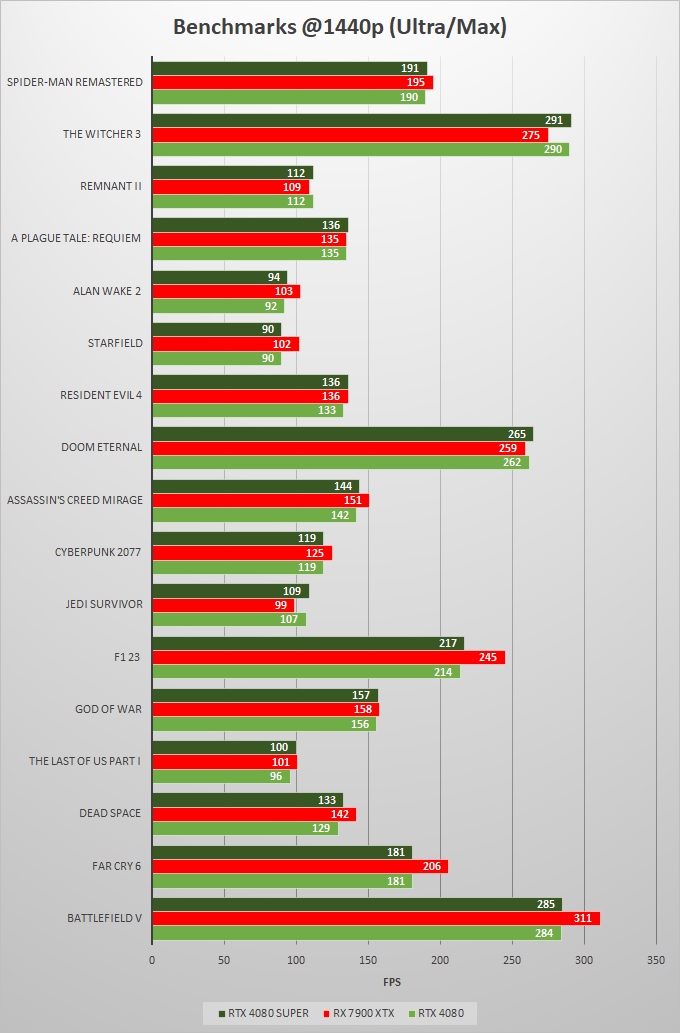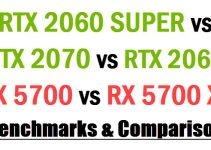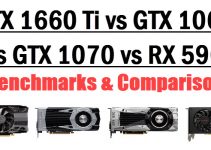RTX 4080 SUPER is the last SUPER card launched in the GeForce RTX 40 series from Nvidia. It is officially a replacement for the older RTX 4080 and that too with a slight increase in performance but a significant reduction in the price. It now also becomes the second most powerful card in the GeForce RTX 40 series lineup after the mighty RTX 4090. The main competitor of RTX 4080 SUPER from AMD is the Radeon RX 7900 XTX which is AMD’s flagship and fastest card in the Radeon RX 7000 series. So, if you want to know how the RTX 4080 SUPER stacks against its competitors in all major areas then please go through the comparison below.

RTX 4080 SUPER vs RX 7900 XTX vs RTX 4080 Comparison
A quick comparison between RTX 4080 SUPER, RX 7900 XTX, and RTX 4080 graphics cards based on their specifications, gaming performance, pricing, power consumption, and features.
GPU Architecture
RTX 4080 SUPER and RTX 4080 are built on the Ada Lovelace architecture on a smaller 5nm fabrication process. Both cards use the same use AD103 chip whereas RTX 4080 SUPER uses the chip in its full capacity with slightly more cores compared to the RTX 4080. RTX 4080 SUPER comes with 10240 CUDA Cores, 80 RT Cores (3rd Generation), and 320 Tensor Cores (4th Generation). On the other hand, RTX 4080 comes with 9728 CUDA Cores, 76 RT Cores (3rd Generation), and 304 Tensor Cores (4th Generation).
Radeon RX 7900 XTX is built on AMD’s RDNA 3 GPU architecture and features a Chiplet design for maximizing performance and lowering costs. The GPU package consists of a Graphics Compute Die (GCD) and multiple Memory Cache Dies (MCD) that surround the GCD. The GCD is built on a 5nm fabrication process whereas MCD is built on a 6nm manufacturing process. The card uses a Navi 31 GPU chip and comes with 6144 Stream Processors, 96 Ray Accelerators, and 192 AI Accelerators.
Must Read: Difference between CUDA Cores and Stream Processors
| RTX 4080 SUPER | RX 7900 XTX | RTX 4080 | |
| GPU Chip | AD103 | Navi 31 | AD103 |
| GPU Architecture | Ada Lovelace | RDNA 3 | Ada Lovelace |
| Fabrication Process | 5nm | 5nm | 5nm |
| CUDA Cores/Stream Processors | 10240 CUDA Cores | 6144 Stream Processors | 9728 CUDA Cores |
| RT Cores / Ray Accelerators | 80 | 96 | 76 |
| Tensor Cores / AI Accelerators | 320 | 192 | 304 |
Video RAM [VRAM]
RTX 4080 SUPER and RTX 4080 come with the same memory capacity and configuration which is 16 GB GDDR6X having a 256-bit interface. The only difference is that the memory of RTX 4080 SUPER is marginally faster at 23 Gbps compared to 22.4 Gbps of RTX 4080. The memory bandwidth of RTX 4080 SUPER is 736 GB/s while that of RTX 4080 is 717 GB/s. On the other hand, RX 7900 XT comes with 24 GB GDDR6 memory with a wider 384-bit interface and runs at a speed of 20 Gbps, delivering a bandwidth of 960 GB/s. Moreover, RX 7900 XTX also comes equipped with 96MB Infinity Cache, an ultra-fast cache that can help to achieve peak memory bandwidth of up to 3500 GB/s.
| RTX 4080 SUPER | RX 7900 XTX | RTX 4080 | |
| Memory Size | 16 GB GDDR6X | 24 GB GDDR6 | 16 GB GDDR6X |
| Memory Interface | 256-bit | 384-bit | 256-bit |
| Memory Speed | 23 Gbps | 20 Gbps | 22.4 Gbps |
| Memory Bandwidth | 736 GB/s | 960 GB/s | 717 GB/s |
| Infinity Cache | NA | 96 MB | NA |
Features
All these graphics cards support Directx 12, OpenGL 4.6, Vulkan 1.2, HDMI 2.1a, AV1, Real-Time Ray Tracing, variable refresh rate technologies G-Sync/FreeSync, and PCIe Express 4.0 x16. Moreover, they also support image upscaling technologies to increase FPS in games, where RTX 4080 SUPER and RTX 4080 support Deep Learning Super Sampling (DLSS 3) while RX 7900 XTX supports AMD FidelityFX Super Resolution (FSR 2 or 3). RX 7900 XTX supports DisplayPort 2.1 for 8K Display Resolution at 165Hz while RTX 4080 SUPER and RTX 4080 do not as they support DisplayPort 1.4a version only.
| RTX 4080 SUPER | RX 7900 XTX | RTX 4080 | |
| Bus Interface | PCI Express 4.0 | PCI Express 4.0 | PCI Express 4.0 |
| DirectX | 12 Ultimate | 12 Ultimate | 12 Ultimate |
| OpenGL | 4.6 | 4.6 | 4.6 |
| Vulkan | 1.3 | 1.3 | 1.3 |
| SLI / CrossFire | NA | NA | NA |
| VR Ready | Yes | Yes | Yes |
| G-Sync/FreeSync | Yes | Yes | Yes |
| HDMI 2.1 | Yes | Yes | Yes |
| DisplayPort 2.1 | No | Yes | No |
| AV1 Support (Encode/Decode) | Yes | Yes | Yes |
| Real-Time Ray Tracing | Yes | Yes | Yes |
| Deep Learning Super Sampling (DLSS) | Yes (DLSS 3) | NA | Yes (DLSS 3) |
| FidelityFX Super Resolution (FSR) | NA | Yes (FSR 2/3) | NA |
Gaming Performance
Here are the gaming benchmarks of these cards at 1440p and 4K resolution in various latest AAA games.
1440p Gaming Benchmarks

4K Gaming Benchmarks

The performance of RTX 4080 SUPER and RTX 4080 is almost the same in almost all games even though RTX 4080 SUPER comes with slightly more cores. RX 7900 XTX is slightly faster than RTX 4080 SUPER with roughly 3 to 5 percent margin only.
Power Consumption
The power consumption of RTX 4080 SUPER and RTX 4080 is the same at 320W. They come with the new 16-pin 12HPWR connector for power. On the other hand, RX 7900 XTX has a higher consumption of 355W and uses the traditional 8-pin PCIe connectors for power.
| RTX 4080 SUPER | RX 7900 XTX | RTX 4080 | |
| Power Connector | 16-pin (12HPWR) | 8-pin PCIe | 16-pin (12HPWR) |
| Power Consumption | 320W | 355W | 320W |
| Recommended PSU | 750W | 800W | 750W |
Pricing & Availability
Talking about the base MSRP at launch, RTX 4080 is priced at $999, a significant drop of $200 compared to the $1199 MSRP of RTX 4080 SUPER. The MSRP of RX 7900 XTX at the time of launch was $999 but now it is reduced to $969. The custom models of these cards can cost more and you can check the latest prices of all models from the links below.
Check RTX 4080 SUPER Price on Amazon
Check RX 7900 XTX Price on Amazon
Check RTX 4080 Price on Amazon
RTX 4080 SUPER vs RX 7900 XTX vs RTX 4080 Specifications
| RTX 4080 SUPER | RX 7900 XTX | RTX 4080 | |
| GPU Chip | AD103 | Navi 31 | AD103 |
| GPU Architecture | Ada Lovelace | RDNA 3 | Ada Lovelace |
| Fabrication Process | 5nm | 5nm | 5nm |
| CUDA Cores/Stream Processors | 10240 CUDA Cores | 6144 Stream Processors | 9728 CUDA Cores |
| RT Cores | 80 | 96 | 76 |
| Tensor Cores | 320 | 192 | 304 |
| Memory Size | 16 GB GDDR6X | 24 GB GDDR6 | 16 GB GDDR6X |
| Memory Interface | 256-bit | 384-bit | 256-bit |
| Memory Speed | 23 Gbps | 20 Gbps | 22.4 Gbps |
| Memory Bandwidth | 736 GB/s | 960 GB/s | 717 GB/s |
| Bus Interface | PCI Express 4.0 | PCI Express 4.0 | PCI Express 4.0 |
| DirectX | 12 Ultimate | 12 Ultimate | 12 Ultimate |
| OpenGL | 4.6 | 4.6 | 4.6 |
| Vulkan | 1.3 | 1.3 | 1.3 |
| SLI / CrossFire | No | No | No |
| VR Ready | Yes | Yes | Yes |
| G-Sync/FreeSync | Yes | Yes | Yes |
| Power Consumption | 320W | 355W | 320W |
| Recommended PSU | 750W | 800W | 750W |
See also:
Final Words
Well, RTX 4080 SUPER does not bring anything new to the table as it is almost an RTX 4080. The only good thing about the RTX 4080 SUPER is the price cut and that too by a great margin. This makes RTX 4080 SUPER a great proposition for buyers who want to have a high-end 1440p and 4K gaming experience at a competitive price. Radeon RX 7900 XTX from AMD is a pretty good card and a great purchase if you don’t mind the higher power consumption and relatively lower Realtime Ray Tracing Performance. If you have anything to say or have some questions regarding these cards then do let me know in the comment section below.
(*This post may contain affiliate links, which means I may receive a small commission if you choose to purchase through the links I provide (at no extra cost to you). Thank you for supporting the work I put into this site!)

![Best RTX 3050 8GB Models for 1080p Gaming [Custom AIB Models] Best RTX 3050 8GB Models for 1080p Gaming [Custom AIB Models]](https://graphicscardhub.com/wp-content/uploads/2022/01/ZOTAC-GAMING-GeForce-RTX-3050-Twin-Edge-211x150.jpg)
